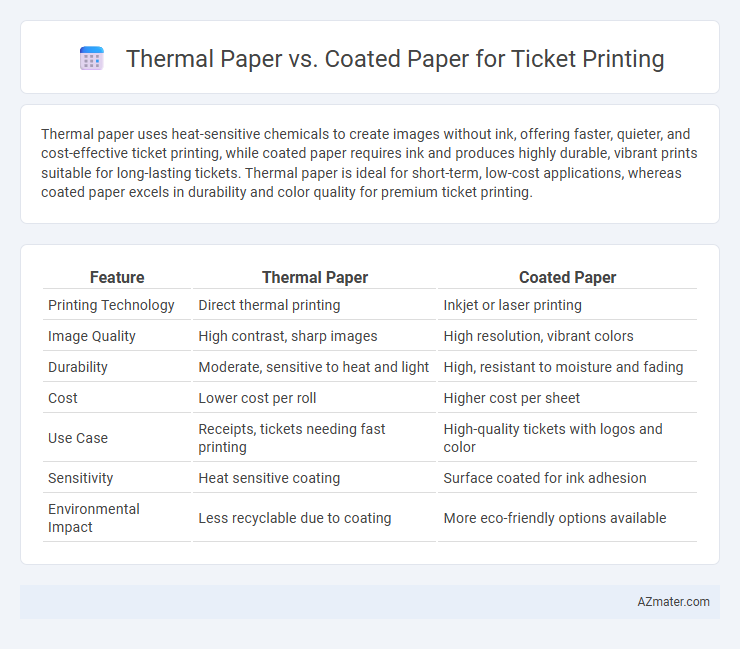Thermal paper uses heat-sensitive chemicals to create images without ink, offering faster, quieter, and cost-effective ticket printing, while coated paper requires ink and produces highly durable, vibrant prints suitable for long-lasting tickets. Thermal paper is ideal for short-term, low-cost applications, whereas coated paper excels in durability and color quality for premium ticket printing.
Table of Comparison
| Feature | Thermal Paper | Coated Paper |
|---|---|---|
| Printing Technology | Direct thermal printing | Inkjet or laser printing |
| Image Quality | High contrast, sharp images | High resolution, vibrant colors |
| Durability | Moderate, sensitive to heat and light | High, resistant to moisture and fading |
| Cost | Lower cost per roll | Higher cost per sheet |
| Use Case | Receipts, tickets needing fast printing | High-quality tickets with logos and color |
| Sensitivity | Heat sensitive coating | Surface coated for ink adhesion |
| Environmental Impact | Less recyclable due to coating | More eco-friendly options available |
Introduction: Understanding Ticket Printing Needs
Thermal paper is designed for heat-sensitive printing processes, offering fast, clear, and smudge-resistant tickets ideal for point-of-sale and event applications. Coated paper, treated with a color layer, provides enhanced durability and print quality, making it suitable for detailed graphics and longer-lasting tickets. Selecting the right paper depends on factors like print speed, ticket durability, and environmental conditions, which directly impact customer experience and operational efficiency.
Defining Thermal Paper and Coated Paper
Thermal paper is a specially coated paper that changes color when exposed to heat, enabling faster and quieter ticket printing without the need for ink or ribbons. Coated paper features a surface layer of clay or polymer to enhance brightness, smoothness, and ink adhesion, making it ideal for high-quality, colored prints but requiring ink-based printers. The key difference lies in thermal paper's heat-sensitive coating that reacts directly to thermal printheads, whereas coated paper relies on traditional ink application for image formation.
Printing Technology: How Each Paper Works
Thermal paper contains a heat-sensitive chemical layer that changes color when exposed to the thermal print head's heat, enabling fast and precise ticket printing without ink or ribbons. Coated paper, on the other hand, relies on traditional ink-based printing, where ink adheres to the smooth surface coating for sharp images and text. Thermal printing technology offers durability and efficiency in environments requiring quick, high-volume ticket production, while coated paper excels in high-resolution, color-rich prints using inkjet or laser printers.
Print Quality and Image Resolution
Thermal paper offers high print quality with sharp, clear images due to its heat-sensitive coating that produces precise details ideal for ticket printing, especially in environments requiring fast, efficient output. Coated paper generally provides better image resolution and color fidelity through ink absorption and a glossy finish, making it suitable for tickets with complex graphics or color branding. While thermal paper excels in durability and smudge resistance under normal conditions, coated paper delivers superior visual appeal and is preferable when high-resolution, vibrant images are essential.
Durability and Longevity of Printed Tickets
Thermal paper offers moderate durability, with prints susceptible to fading over time when exposed to heat, light, or chemicals, making it suitable for short-term ticketing needs. Coated paper provides enhanced longevity due to its protective surface layer that resists smudging, moisture, and wear, ensuring printed tickets maintain clarity for extended periods. When durability and long-term preservation are critical, coated paper is the preferred choice for ticket printing applications.
Cost Comparison: Thermal vs Coated Paper
Thermal paper generally offers lower operational costs compared to coated paper due to the elimination of ink or toner requirements, reducing both material expenses and maintenance. While coated paper incurs additional printing costs from ink usage and slower print speeds, thermal paper's direct heat-sensitive technology enhances efficiency and reliability. Despite a higher upfront price for thermal paper rolls, the total cost of ownership is often lower, making thermal paper a cost-effective choice for high-volume ticket printing.
Environmental Impact and Recyclability
Thermal paper contains a chemical coating that can release bisphenol A (BPA) or bisphenol S (BPS), posing environmental and health concerns, while coated paper is typically safer and more eco-friendly. In terms of recyclability, coated paper blends well in standard recycling processes, whereas thermal paper often complicates recycling due to its chemical layers. Choosing coated paper for ticket printing supports sustainable practices by minimizing toxic waste and enhancing recyclability.
Security Features and Counterfeit Prevention
Thermal paper for ticket printing incorporates embedded heat-sensitive inks and multiple security features such as watermarks, UV-reactive coatings, and microtext to prevent counterfeiting. Coated paper, while offering a smooth printable surface, often relies on added security elements like holograms, foil stamping, and tamper-evident seals rather than intrinsic heat-reactive properties. Advanced thermal papers provide higher counterfeit resistance through integrated chemical layers that react to physical tampering and unauthorized heat exposure, making them preferred for secure ticketing applications.
Suitability for Different Ticketing Applications
Thermal paper offers fast, cost-effective printing ideal for high-volume, short-term tickets such as parking or event entry passes, providing crisp images without ink. Coated paper, with its durability and resistance to smudging, suits longer-lasting tickets like transportation or admission tickets requiring archival quality. Selecting the appropriate paper enhances print longevity and clarity based on the specific ticketing application's durability and image quality needs.
Choosing the Right Paper: Key Considerations
Thermal paper offers a smooth, heat-sensitive coating ideal for high-speed ticket printing with sharp, clear images but requires thermal printers and is sensitive to heat and light exposure. Coated paper, featuring a protective layer that enhances ink adhesion and durability, supports various printing technologies like inkjet and laser, making it versatile for tickets needing longer lifespan and resistance to wear. Selection depends on printer compatibility, print durability requirements, and environmental conditions to ensure optimal ticket quality and performance.

Infographic: Thermal paper vs Coated paper for Ticket printing
 azmater.com
azmater.com